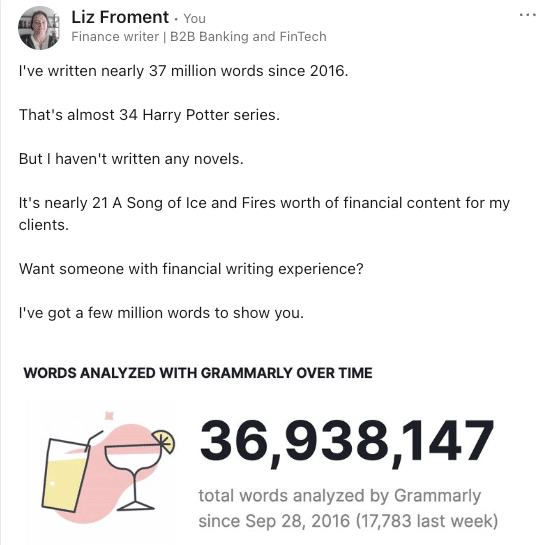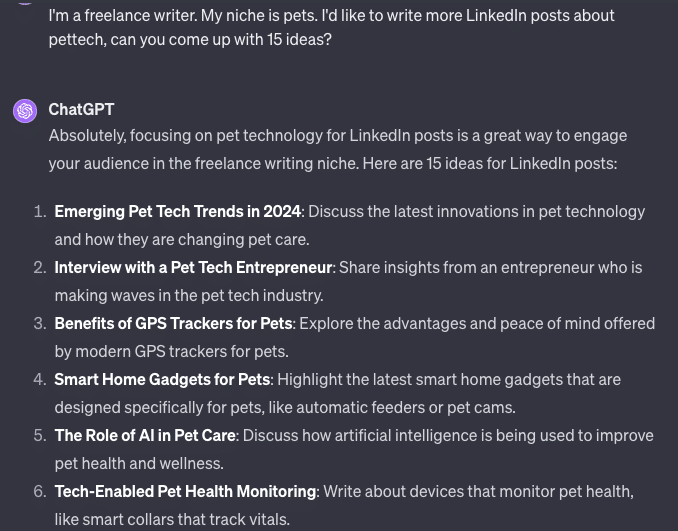There’s one social media channel that you really can’t afford to not be on right now.
You might have guessed LinkedIn.
Why?
Because that is the platform that’s business-focused, where people are looking for thought leadership, they’re looking for ideas; they’re looking for other people that can help them with their goals.
And if you can establish yourself as an expert and build a strong personal brand around your business and what you do on LinkedIn, it will open up a whole bunch of doors for you.
So if you want to have a successful freelance writing business, it’s time to master LinkedIn.
I’ve got five strategies to help ensure you’re leveraging your time properly and giving yourself the best chance for success on this platform.
Sound good? Keep reading.
And if video is more your thing, watch below.
Five Strategies to Master LinkedIn
If you aren’t on LinkedIn yet, it’s time to jump on the platform.
To do that, check out this post.
Even though LinkedIn has blown up in popularity over the last few years, there’s no reason to put off getting on there any longer. It’s the best platform to find potential clients.
If you’re not sure how to get started with LinkedIn, here are five strategies to start.
Write to Potential Clients, Not Other Freelancers
I see this all the time: people go to LinkedIn, and they’re in a bunch of freelance writing communities. They’re talking to other freelance writers and networking with other freelance writers because that’s kind of who they engage with.
So that’s naturally who they’re going to network with and build relationships with. And that’s great.
Building relationships with other freelancers is going to open a whole bunch of doors for you. But that’s not the best way to find clients on LinkedIn.
If someone’s scrolling through your LinkedIn page, you want them to know exactly what you do and who you’re targeting. Scroll through your profile now.
Is that clear? Are your posts targeted at the people who want to hire you?
Or are all your posts targeted at other freelancers?
If that’s the case, then you’re missing out on potential clients because you’re not speaking directly to them, their interests, and their needs.
Overcome Your Posting Anxiety
Don’t feel like you have to post content every single day. A lot of the conventional wisdom is if you want to have success, find clients, and build relationships, you need to be putting yourself out there day in and day out every day.
That can be overwhelming, and it’s very common to feel imposter syndrome here. So many of the freelancers I know who don’t have much of a LinkedIn presence cite that as the biggest stressor. They don’t know what to say. More on that later, but here’s the truth: you don’t need to post frequently, just consistently.
Posting just once or even twice a week over the course of a couple of months can have massive results. For every piece of good content you put out there, you have a greater chance of it being seen by the people you’re targeting.
But don’t stress yourself out thinking you have to do it all the time.
Just set a cadence — every Monday and Thursday for 2x a week or every Wednesday for 1x a week. You can even plan some ideas and pre-schedule them to build a little buffer.
That way, you’re building a library of content and catching the eye of potential clients but not stressing yourself out with another thing on your plate.
Focus on Engagement
If you want to master LinkedIn, realize it is a long-term strategy, a marathon, not a sprint. It’s going to take a while for people to find you.
But that doesn’t mean you can’t speed things up a little bit.
The best way to do that?
Sending connection requests and commenting on other people’s posts (ideally, your prospects). I’d focus on finding and then following your prospects and engaging with them regularly.
Ideally, you’ve got a ton of them on your list, and that makes it easy to pop on LinkedIn for 20 minutes and comment on a handful each day. I’d even argue that commenting and sending connection requests are more important than posting.
Ed Gandia has a great technique he calls the 3-2-1 method, and that’s sending three connection requests, making two comments, and writing one post a day. But even if that feels a bit much, pick a number like five or three and aim to do three things on LinkedIn every day — that could be three connection requests, two comments and a post, or three comments.
Make it a habit to be on there and engage. The more often you do that, the better the chances of paying dividends down the road.
Optimize Your Profile for Clients
So, in point number one, we talked about how the content you’re creating on the site should be client-focused, not freelance writer-focused. Well, the same holds true for your profile.
Go back to your profile, edit it, and treat it like a sales page. Remember, you’re selling yourself.
Highlight the clients that you’ve worked with, talk about wins you’ve gotten for them, share testimonials with people that you’ve worked with who have been thrilled with the results, link to your portfolio website, and show how you can help others.
No one is going to advocate for you and how great you are. So you have to advocate for yourself, and your LinkedIn profile is the best place to do that.
It helps for stuff beyond LinkedIn too. Most job applications I see today (even freelance writing gigs) want to see your LinkedIn page. And most brands and the people who hire you will take a peek at it to learn more about you.
So make sure it’s up to snuff.
By treating it like a sales page and making it really clear what you bring to the table, plus having a consistent backlog of posts and comments, you have a winning strategy to grab some eyes and hopefully get more interested prospective clients.
Build Your Idea Brain
Remember how I said so many people get stuck because they don’t know what to post?
Here’s a solution: build your idea brain.
Write down 10 ideas in a notebook, notes app, or Google Doc every single day. Most of those ideas will be crap, but a few will be good. And at the end of each week, if you have 70 new ideas, there’ll probably be a chance that 5-10 of them are going to be pretty good.
Take the good ones, and create posts out of those.
Do that every week, and now, suddenly, you have piles of post ideas in your library. That means you can pre-schedule some stuff, and suddenly, the pressure to come up with great stuff to post every week goes away.
Plus, I think an exercise like this is a great way to get your brain always on the lookout for potential ideas.
But if you’re really stuck?
Turn to AI writing tools like ChatGPT. Writer’s block should never be a thing anymore.
Open it up and ask for ideas for 10 LinkedIn posts about your niche. Then, ask for more if you need to, and you have a starting place to tap into your own thinking to expand or riff on what AI gave you.
Twenty to Thirty Minutes a Day on LinkedIn Can Make a Huge Difference
If you can spend even 20 to 30 minutes a day on LinkedIn as a freelancer, it is going to pay so many dividends.
Just this last week, I’ve talked to three different freelancers who have said most of their leads and clients these days are coming from LinkedIn. So, investing time in that platform is really important.
And it will pay off in different ways. Sure, getting more clients is great. But it can also help build a bigger network and more relationships with other freelancers, which is pretty awesome, too. Since that’s where a lot of job security comes from, the bigger your network, the more job security.
And that’s super valuable today.
All that’s to say, don’t delay getting on LinkedIn any longer. I promise, if you put in the time and effort, it’s going to pay off over the next year.
Sean Ogle
Sean Ogle is the Founder of Location Rebel where he has spent the last 12+ years teaching people how to build online businesses that give them the freedom to do more of the things they like to do in life. When he's not in the coffee shops of Portland, or the beaches of Bali, he's probably sneaking into some other high-class establishment where he most certainly doesn't belong.Join over 40,000 people who have taken our 6 part freelance writing course. Sign up below and let’s do this together.
By entering your email address you agree to receive emails from Location Rebel. We'll respect your privacy and you can unsubscribe at any time.



